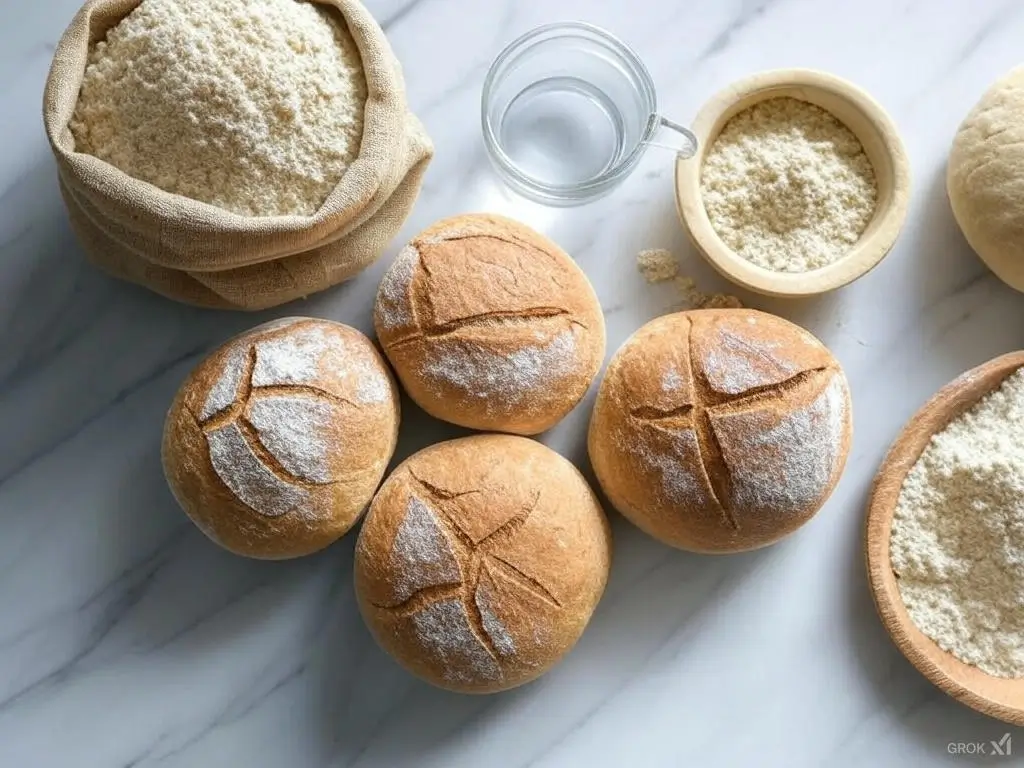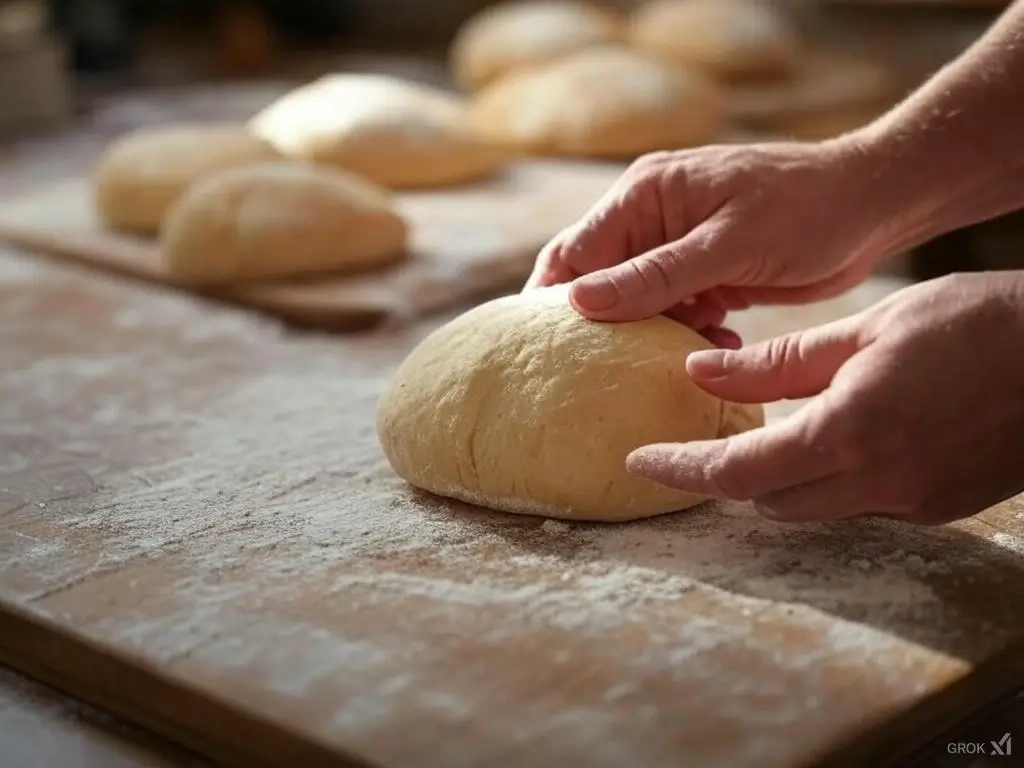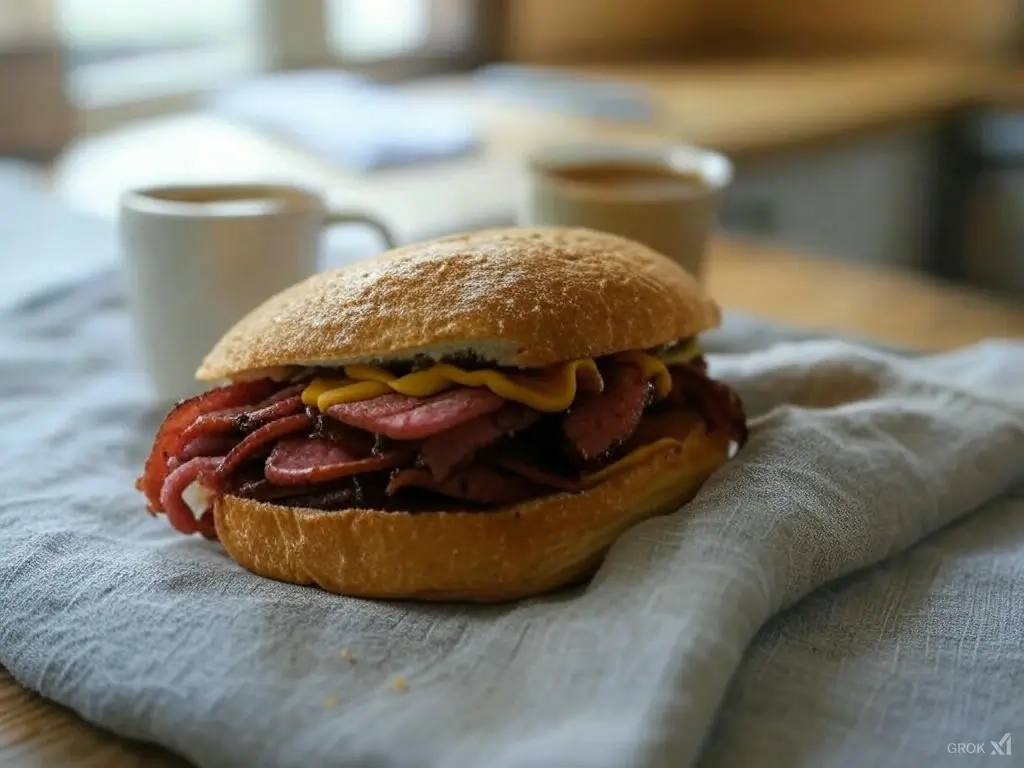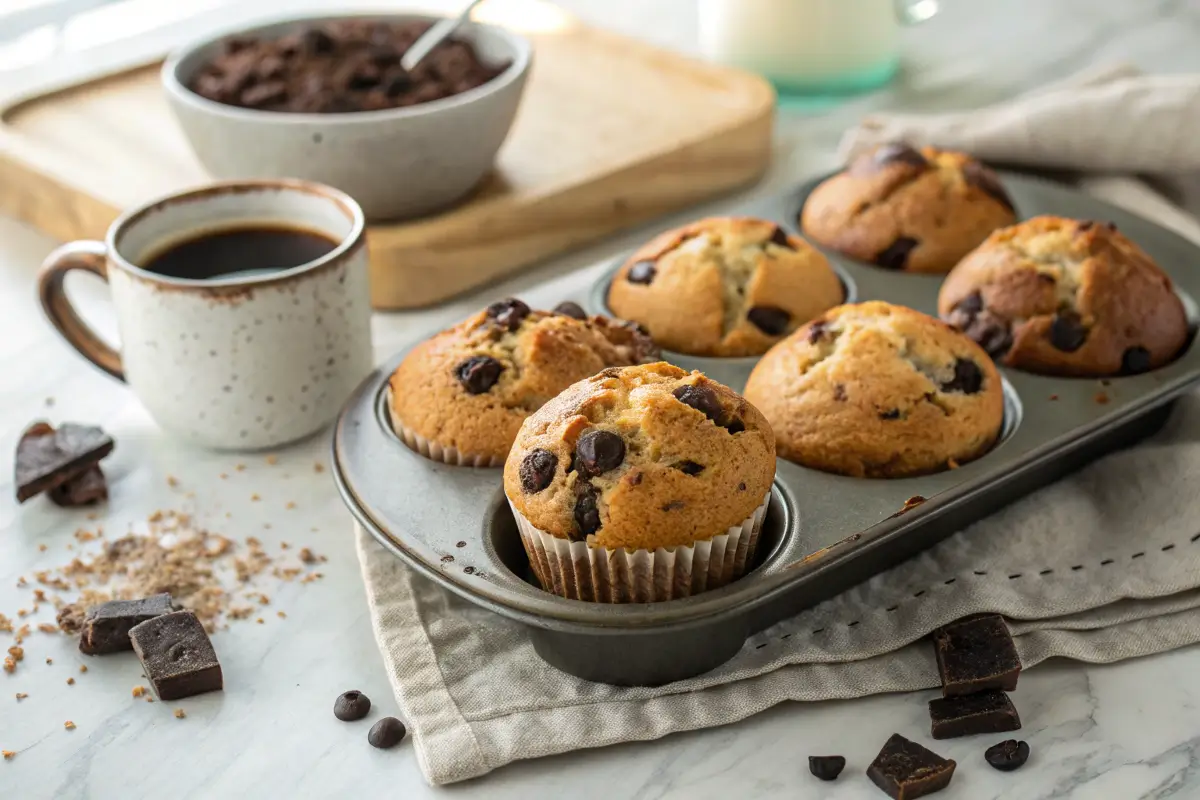Have you ever bitten into a crusty, golden Kaiser roll and wondered what makes it so irresistibly delicious? Whether it’s cradling your favorite sandwich or stealing the show at breakfast, this classic bread has a story—and ingredients—that will surprise and delight you. Dive into this comprehensive guide to uncover everything about Kaiser rolls, from their unique composition to their rich history, and get ready to impress your friends with your newfound bread expertise!
What is in a Kaiser Roll? Exploring the Essential Ingredients
Oh boy, if you’ve ever held a Kaiser roll, you know it’s more than just bread—it’s a little masterpiece. But what’s the magic inside? Let’s break it down and explore what is in a Kaiser roll, starting with the basics that make it tick. Trust me, it’s simpler than you’d think, yet oh-so-clever.
Try this delicious variation of Peanut Butter Pie with Chocolate Ganache for a unique twist on a classic dessert.
Breaking Down the Core Components of a Kaiser Rolls

First off, the building blocks of this iconic bread aren’t fancy schmancy—they’re everyday heroes. Still, they team up to create something downright special. Here’s the lowdown.
What Flour is in a Kaiser Roll?
At its heart, a Kaiser roll leans on flour—usually good ol’ bread flour. Why? Because it’s got that high protein punch, giving the roll its chewy insides and sturdy crust. Some bakers might sneak in a bit of all-purpose flour, but bread flour’s the star. Without it, you’d miss that satisfying bite. Pretty cool, huh?
Is Yeast the Secret to What’s in a Kaiser Roll?
Next up, yeast. Yep, this tiny powerhouse is what makes a Kaiser roll rise like nobody’s business. Mixed into the dough, it puffs things up, creating that airy, fluffy crumb we all crave. Honestly, without yeast, what’s in a Kaiser roll would feel flat—literally! It’s the unsung hero, working behind the scenes to lift your sandwich game.
The Role of Water and Salt in a Kaiser Rolls
Now, let’s talk about the supporting cast—water and salt. These unsung champs might seem basic, but they’re pulling heavy weight in every bite.
How Much Water Goes Into a Kaiser Roll?
Water’s the glue, folks. Typically, it’s about 60% of the flour’s weight—enough to hydrate the dough and kickstart that Kaiser roll texture. Too little, and you’re stuck with a dry brick; too much, and it’s a soggy mess. Bakers nail this balance to keep things just right. Pretty neat how something so simple shapes what is in a Kaiser roll, right?
Why Salt Matters in What’s in a Kaiser Rolls
And then there’s salt—don’t sleep on it! A pinch (about 1-2% of the flour) doesn’t just boost flavor; it tightens the dough, making it stronger. Ever wonder why your homemade Kaiser rolls taste bland without it? Salt’s the quiet MVP, ensuring every bite pops with that subtle zing.
Discover the ultimate Peanut Butter Pie with Chocolate Ganache recipe that will satisfy your sweet cravings
What is in a Kaiser Rolls’s Unique Texture and Shape?
So, you’ve got the basics of what’s in a Kaiser roll down—flour, yeast, and all that jazz. But what about that crispy crust and cool star shape that make it stand out? Honestly, these are the real showstoppers. Let’s dig into the how and why behind the Kaiser roll texture and its iconic look.
The Science Behind the Crusty Exterior
First things first, that crunchy outside isn’t just luck—it’s science doing its thing. Ever wonder what gives a Kaiser roll its signature snap? Buckle up, because it’s pretty neat.
Does Steam Affect What’s in a Kaiser Roll’s Crust?
You bet it does! Steam’s the secret sauce here. When bakers pop the dough into a hot oven, they toss in some steam—think of it like a spa day for bread. For the first few minutes, this keeps the surface soft, letting it stretch before hardening into that golden, crusty shell. Without it, what is in a Kaiser roll would be dull and tough—nobody wants that!
What Role Does Oven Temperature Play in a Kaiser Roll?
Next up, heat’s the MVP. A blazing oven—usually around 425°F—works fast to lock in that Kaiser roll texture. Too low, and the crust flops; too high, and it burns before the inside cooks. So, bakers play Goldilocks to get it just right. Pretty wild how a dial tweak changes everything, huh?
Decoding the Star-Shaped Design
Now, let’s talk about that fancy Kaiser roll shape. It’s not just pretty—it’s a tradition wrapped in dough. Here’s how it happens.
How is the Kaiser Roll Shape Made?
Surprise—it’s all hands-on! Bakers roll the dough into a rope, then tie it into a knot or fold it five times to form that star. No cookie cutters here, just skill. This trick traps air inside, boosting the fluffy crumb. So, what’s in a Kaiser roll isn’t just ingredients—it’s craft too!
Are There Tools Involved in Shaping What’s in a Kaiser Rolls?
Well, sometimes. Traditionalists stick to their fingers, but some modern bakers use a Kaiser roll stamp—a little gadget that presses the pattern in one go. Either way, that star’s what makes it a Kaiser. Cool, right? Next time you grab one, you’ll see the artistry in every bite.
Learn about the history and unique characteristics of the Kaiser Rolls, a classic bread known for its crown-like shape and white flour base.
What is in a Kaiser Roll Historically? A Journey Through Time
Okay, we’ve cracked the code on what is in a Kaiser roll today, but where’d it come from? Spoiler: it’s got a backstory fit for a king—literally! Let’s hop in the time machine and explore the Kaiser roll history.
Origins of the Kaiser Roll in Austria
Picture this: Vienna, centuries ago, bustling with bakers and bigwigs. That’s where the Kaiser roll was born, and it’s got royal vibes all over it.
Who Invented What’s in a Kaiser Roll?
No one’s 100% sure, but legend points to Viennese bakers in the 1700s. They whipped up this bread to honor Emperor Franz Joseph—or so the story goes. Whether it’s true or not, these folks knew how to make dough sing. So, what’s in a Kaiser roll started as a tribute, and it stuck!
What Inspired the Name “Kaiser” in Kaiser Rolls?
Here’s the fun part: “Kaiser” means “emperor” in German. Some say bakers stamped the rolls with a crown-like shape to nod at the monarchy. Others think it was just a fancy name to sell more loaves. Either way, by the 1800s, this Viennese bread was a hit across Austria. Talk about a glow-up!
Evolution of Kaiser Rolls Across Cultures
Fast forward, and the Kaiser rolls didn’t stay put—it traveled the world. Immigrants, wars, and delis all had a hand in its journey.
How Did Immigrants Influence What’s in a Kaiser Roll?
When Austrians and Germans hit the U.S. in the 19th century, they brought their Kaiser rolls recipe along. In places like New York, it morphed into a sandwich king—think pastrami piled high. The crust got thicker, the size beefed up, but the heart stayed the same. Pretty awesome how it adapted, right?
Are There Regional Twists in What’s in a Kaiser Roll?
Oh, totally! In Germany, you might find denser versions with rye hints. Back in Austria, they’re lighter, sometimes dusted with seeds. And in America? Supersized for burgers! So, what is in a Kaiser roll shifts a bit depending on where you are—it’s like bread with a passport.
Looking for alternatives? Learn what you can substitute for chocolate in the ganache to customize your dessert.
What is in a Kaiser Rolls Nutritionally? Health and Dietary Insights
So, we’ve uncovered the ingredients and history of a Kaisers roll, but what about the nitty-gritty of what’s in a Kaiser roll for your body? Spoiler: it’s not just empty carbs! Let’s break down the Kaiser roll nutrition and see how it fits into your diet. Ready? Here we go!
Caloric Breakdown of What’s in a Kaiser Roll
First off, let’s talk numbers. If you’re counting calories or just curious, this part’s for you—because who doesn’t want to know what they’re munching on?
How Many Calories Are in a Kaiser Roll?
On average, a standard Kaiser roll—about 2-3 ounces—packs around 150-200 calories. Pretty reasonable, right? Most of that comes from carbs, thanks to the flour, with a smidge of protein tossed in. So, it’s a solid energy boost, especially if you’re piling on sandwich goodies.
What Nutrients Are Packed in a Kaiser Roll?
Besides calories, there’s more to the story. You’ll get some B vitamins from the flour—think energy helpers like thiamine. Plus, a little iron sneaks in there too. However, it’s not a nutrient powerhouse—more of a tasty sidekick. Still, every bite counts, don’t you think?
Dietary Considerations for Kaiser Rolls
Now, let’s switch gears. Can everyone enjoy this bread, or are there catches? Turns out, it depends on your plate.
Is There Gluten in What’s in a Kaiser Roll?
Yep, gluten’s a big player here. Since what is in a Kaiser roll includes wheat flour, it’s a no-go for folks with celiac disease or gluten sensitivity. Bummer, but there are gluten-free swaps out there if you’re craving that vibe!
Can Vegans Enjoy What’s in a Kaiser Rolls?
Good news—usually, yes! Traditional recipes stick to flour, yeast, water, and salt—all vegan-friendly. But watch out: some bakers brush on egg wash for shine, so check the label. Otherwise, it’s a green light for plant-based eaters.
Follow this step-by-step Kaiser Rolls Recipe from King Arthur Baking to create soft, authentic rolls at home.
What is in a Kaiser Roll Recipe? Making Your Own at Home
Alright, you’re hooked on what is in a Kaiser roll, so why not bake your own? Seriously, there’s nothing like pulling fresh homemade Kaiser rolls from the oven—all crusty and warm. Plus, it’s easier than you’d guess. Let’s roll up our sleeves and get into the Kaiser rolls recipe details!
Step-by-Step Ingredients for a Homemade Kaiser Roll
First things first, you’ll need the right stuff. Don’t worry—it’s all pantry staples, but they team up for magic.
What’s in a Kaiser Roll Dough You Can Make?
Here’s the lineup: about 3 cups of bread flour, 1 teaspoon of yeast, 1 cup of warm water, 1 teaspoon of salt, and a pinch of sugar to wake up the yeast. That’s it! Mix ’em up, knead for 10 minutes, and you’ve got dough ready to rise. Simple, yet what’s in a Kaiser rolls starts here—so cool!
Are Optional Add-Ins Part of What’s in a Kaiser Roll?
Want to jazz it up? Totally optional, but some folks toss in a teaspoon of malt powder for a richer flavor—or sprinkle poppy seeds on top for crunch. Not traditional, but hey, your kitchen, your rules. Either way, it’s a tasty twist.

Baking Techniques to Master What’s in a Kaiser Roll
Now, the fun part—turning dough into rolls. It’s not hard, but a few tricks make all the difference. Let’s nail it.
How Do You Proof What’s in a Kaiser Roll Dough?
After kneading, let the dough chill out in a warm spot for about an hour—it’ll double in size. Then, shape those star patterns (knot or fold, your call) and let ’em rest another 30 minutes. Why? This proofing pumps up the Kaiser roll texture—light and fluffy wins every time!
What’s the Best Way to Bake a Kaiser Roll?
Finally, crank your oven to 425°F. Pop the rolls in, add a splash of steam (toss water on the oven floor or use a spray bottle), and bake for 15-20 minutes. Boom—golden, crusty perfection! Pro tip: cool them on a rack so the bottoms don’t sog out. Trust me, the smell alone is worth it.
Master the art of baking with this comprehensive Kaiser Roll Guide for perfect homemade rolls.
FAQs About What is in a Kaiser Roll?
Common Questions from “People Also Ask”
First up, folks online are curious about how this bread stacks up and what’s in it. Let’s clear the air.
What’s the Difference Between a Kaiser Roll and a Hamburger Bun?
Good question! While both are bread buddies, they’re not twins. A Kaiser roll rocks a crisp, hard crust and that cool star shape—perfect for hefty sandwiches like pastrami or roast beef. Hamburger buns? Softer, rounder, and sweeter, built for burgers. So, the Kaiser roll texture wins for crunch, while buns go for squish. Use what fits your vibe!
Is There Sugar in What’s in a Kaiser Roll?
Not much, usually! Traditional recipes skip sugar or use just a pinch to kickstart the yeast—no sweetness here. Unlike some fluffy buns, what’s in a Kaiser roll keeps it savory, letting the crust and chew shine. That said, some modern twists might sneak in a teaspoon—check your bakery’s style!
Insights from AnswerThePublic.com
Now, let’s dive into what the public’s buzzing about. These questions get right to the roll’s quirks.
Why Are Kaiser Rolls Hard on Top?
It’s all about that crust! The hard top comes from steam and high heat in the oven—trapping moisture early, then crisping up fast. That firmness? It’s why Kaiser rolls hold up to juicy fillings without falling apart. Plus, that snap when you bite in? Pure bliss!
What Goes Best with What’s in a Kaiser Roll?
Oh, the possibilities! Think deli classics—pastrami, corned beef, or turkey with Swiss. Or go simple: butter and jam for breakfast. The Kaiser roll sandwich shines with bold flavors, so pile on pickles, mustard, or even a burger patty. Honestly, it’s a champ with anything hearty!

Conclusion: Wrapping Up What is in a Kaiser Roll
From its humble Austrian roots to its sandwich-starring role today, the Kaiser roll is a bread with serious swagger. We’ve unpacked what is in a Kaiser roll—flour, yeast, water, and salt blending into a crusty, chewy dream. Then there’s the star shape, baked with steam and skill, plus a history tied to emperors and immigrants. Nutritionally, it’s a solid pick—light on frills, big on energy. And if you’re feeling bold, that Kaiser roll recipe lets you whip up your own batch at home.
Whether you’re a bread nerd or just here for the eats, this roll’s got a story—and a taste—that hooks you. So, next time you grab one from the deli or pull a tray from your oven, you’ll know the magic behind every bite. It’s not just food; it’s a little piece of tradition, crafted to perfection. Go ahead—dig in, share the trivia, and maybe even bake a few. After all, now that you get what’s in a Kaiser roll, why not enjoy it to the fullest?
Wondering about the nutritional content? Check out the Kaiser Roll Calories breakdown to make informed choices.
Explore the art of reproducing the nostalgic flavors of the 1970s Midwestern Kaiser Roll with this detailed guide from The Fresh Loaf.






